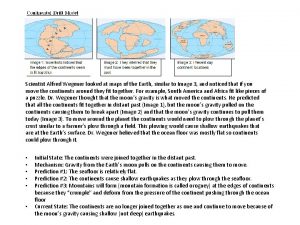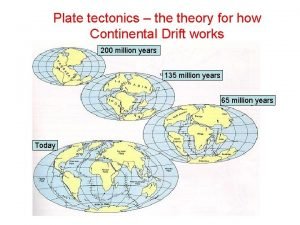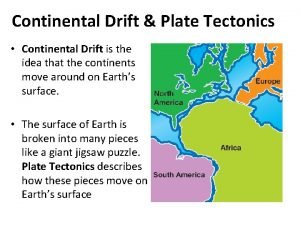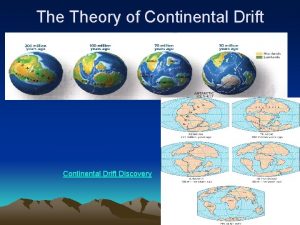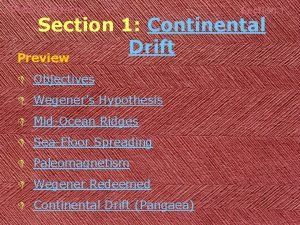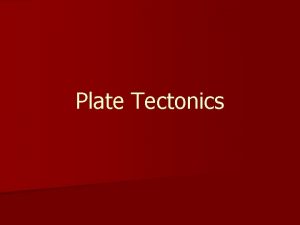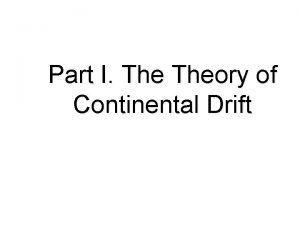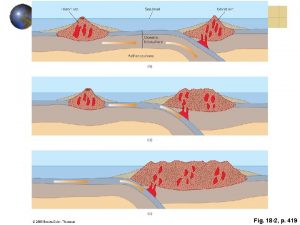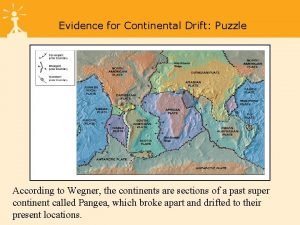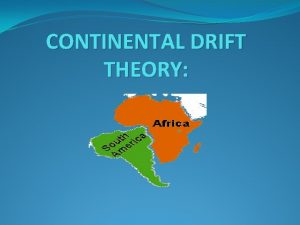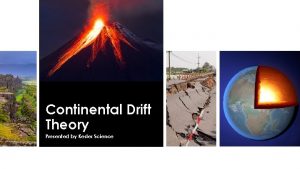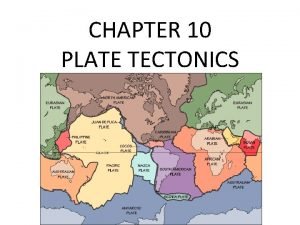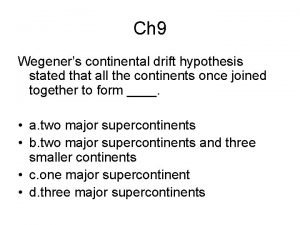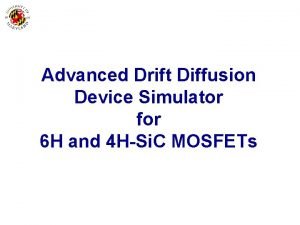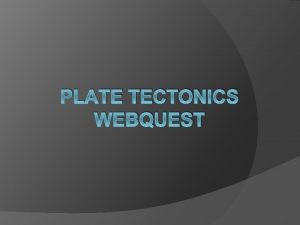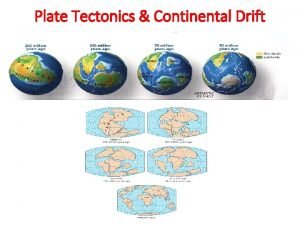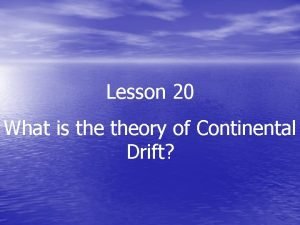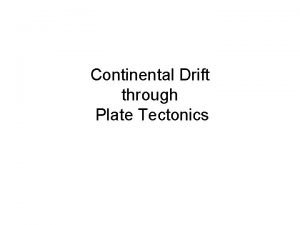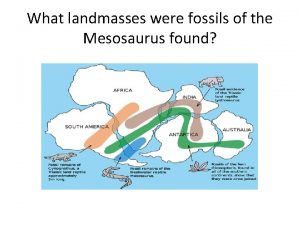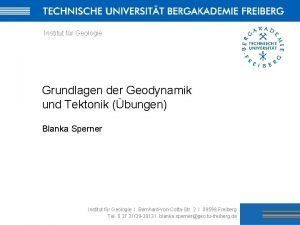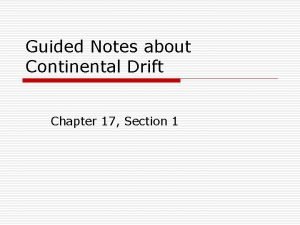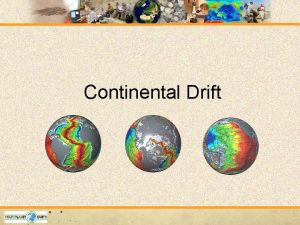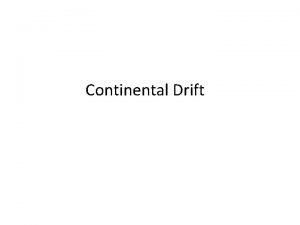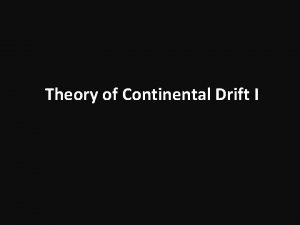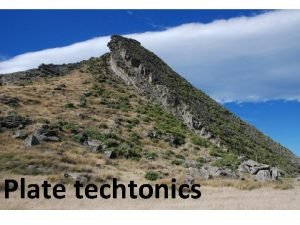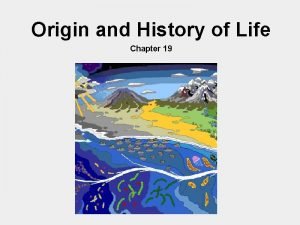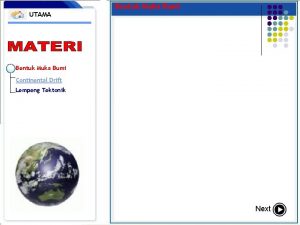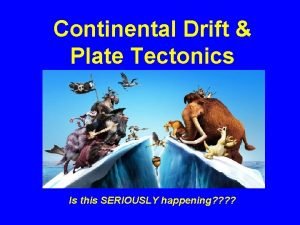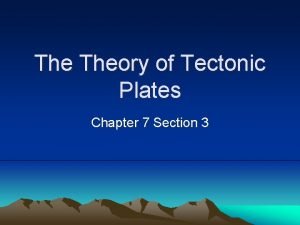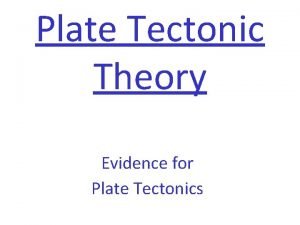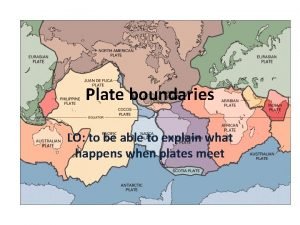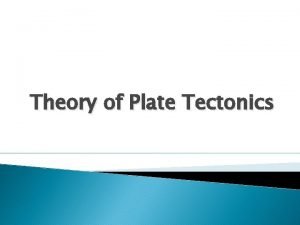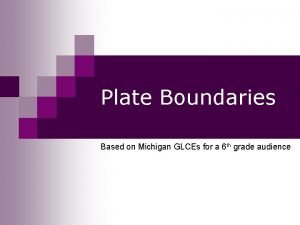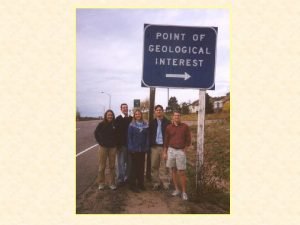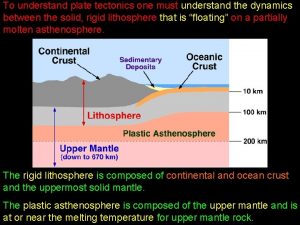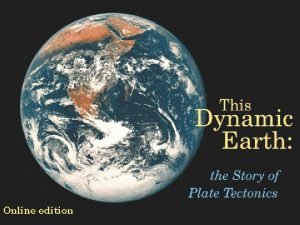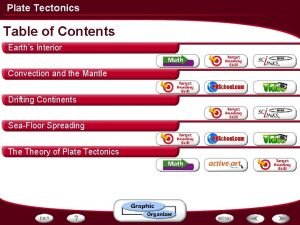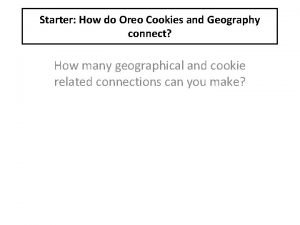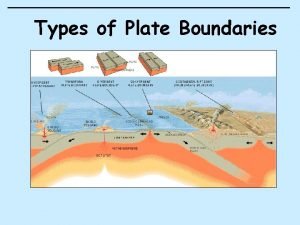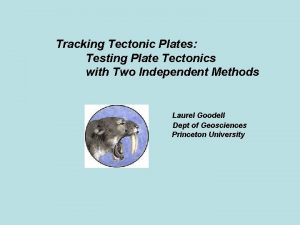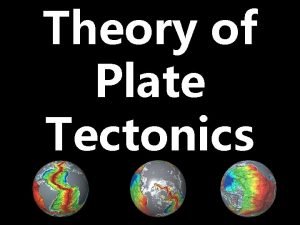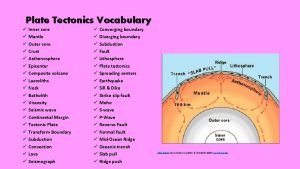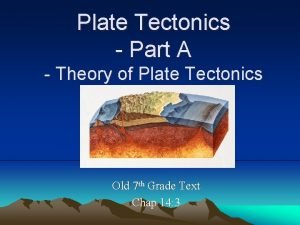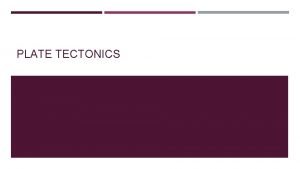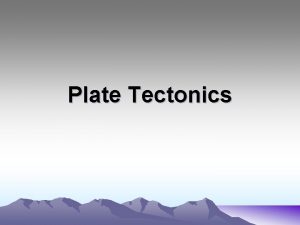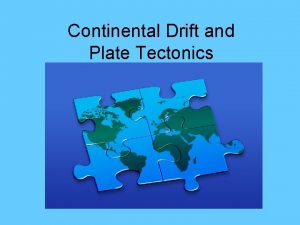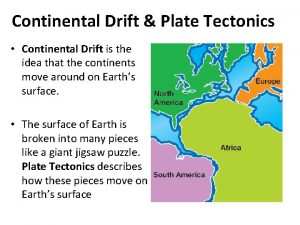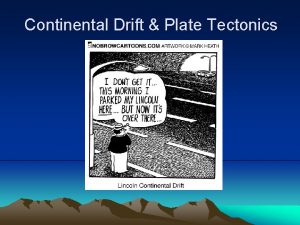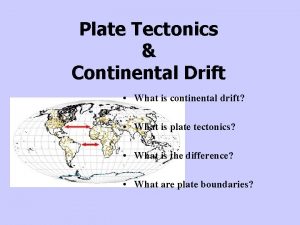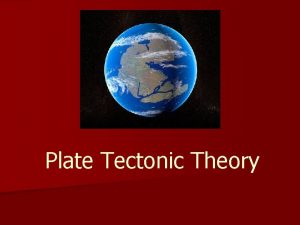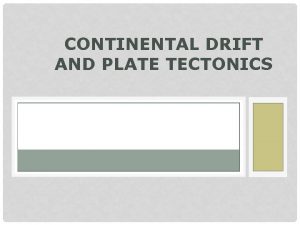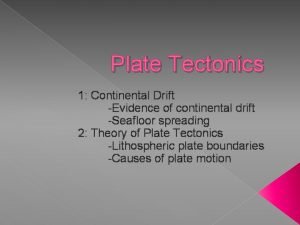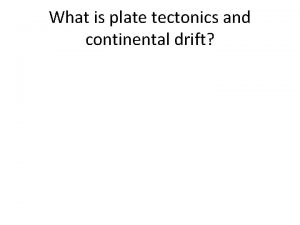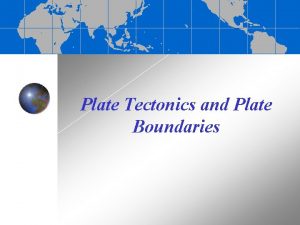Plate Tectonics and Continental Drift Tectonics Tectonic Forces


























































- Slides: 58

Plate Tectonics and Continental Drift

Tectonics Tectonic Forces are forces generated from within Earth causing rock to become______. deformed Tectonics 1. The study of the origin and arrangement of Earth surface including mountain belts, continents, and earthquake belts.

Plate Tectonics 1. This is the basic idea that Earths crust is divided plates into a few large, thick ______ which are large slabs of the lithosphere move slowly (a) Plates are part of the_______ and change in size. (b) Plates may be: sea floor rock (a) entirely ______ sea floor and _______ continental rock (b) both ______ continental rock (c) entirely _______

Inferred Properties of Earth’s Interior

Lithosphere and Upper Mantle Defined by a decrease in P-wave velocities

2. Alfred Wegener and the Continental Drift Hypothesis • German meteorologist • Credited with hypothesis of continental drift

Wegener’s Evidence For Continental Drift Pangaea A. ______ – Wegener proposed the presence of a giant continent, Pangaea (also spelled Pangea), which literally translated means “all lands. ” – When it split apart it separated into two parts with the proto-Atlantic between them (called Tethys Sea). Laurasia (1) ______was the northern supercontinent that contained present-day North America and Eurasia (not including India Gondwanaland (also called Gondwana) was the (2) ___________ southern supercontinent, composed of all present-day southern hemisphere continents and India.


B. Jig-Saw _______ Fit of Continents Shorelines of continents seem to fit together

Rock Types Between Continents C. Matching __________ Continental Shelf (light blue) Broad belts of rocks that Correlate in type and age

Matching Mountain Ranges D. __________ When continents are brought together, their mountain ranges form a single continuous range of the same age and style of deformation.

Fossil Evidence E. _____ i. Almost identical late Paleozoic fossils in South America, Africa, India, Antarctica, and Australia. ii. Bones of land reptiles have been found in Antarctic rocks. Antarctica is now completely separate and isolated from other continents.

iii. _______ Glossopteris (1) A Late Paleozoic plant found in rocks on all five continents. (2) When the land areas are joined, similarity can be seen.

Reptiles iv. Extinct ________ • Areas where found reveal narrow, sharply defined habitats extending across: – three continents and – the subcontinents of Madagascar and India. • The shape of the animals ranges can best be explained by assuming that these lands were once united as one landmass.

Mesosaurus • A freshwater carnivorous reptile; cm long • Fossils found in Permian-aged rocks in Brazil and Africa

Lystrosaurus • Early Triassic terrestrial mammal-like reptile • About 1 meter long with two long teeth protruding from the upper jaw • Fossils found in Africa, India, and Antarctica

Cynogathus • Early Triassic terrestrial mammal-like reptile • About 1 meter in length • Fossils found in Brazil and Africa

Fossil Evidence

v. Late Paleozoic _____ Glaciation Glacial evidence shows the Origin of the glaciers in the Atlantic Boulders in S. America traced to a source in Africa • Distribution of Late Paleozoic continental glacial evidence on the Gondwanaland continents can only be explained by a supercontinent.

vi. Paleoclimates _______ (Ancient Climates) a. Inferring the Location of the Poles • If it is assumed that ancient climates had the same geographic distribution as present-day climates, • then the distribution of sedimentary rocks can be used to infer the locations of the ancient poles and the paleoequator.

Glacial Evidence (1) Glacial ____ till (soil) and _____ striations (scratches) on bedrock are found in cold polar climates.

Coral Reefs • Coral reefs are found in tropical regions (as far as 300 north or south of the equator)

Cross-Bedded Sandstones • Indicate the locations of ancient deserts • Latitudes of 30 o

F. However -- • Despite Wegner’s evidence, his hypothesis was rejected because he could not explain a possible mechanism by which the continents moved! • It wasn’t until 1947 that this mechanism was discovered – 17 years after Wegner’s Death!

3. Plate Tectonics combines two preexisting ideas (a)__________which is the idea that Continental Drift the continents move freely over Earth’s surface, changing their positions relative to one another Sea-Floor Spreading which is the (b)__________ hypothesis that sea floor forms a mid-oceanic ridge crests and then moves horizontally away from the ridge towards oceanic trenches.

Sea Floor Spreading b. This is the hypothesis that: 1. Was originally proposed by Harry Hess, a Princeton University geologist 2. 3. 4. Sea floor forms at the______ Mid-ocean ridge The sea floor moves _________ horizontally from the ridge crest toward an oceanic trench where it subducts ______. The two sides move in opposite directions _____ Convection 5. ________ in the mantle is the driving force.

4. The Evidence…

A. The Mid-Ocean Ridge 1. Hot mantle rock rises beneath the ridge as a result of convection 2. This explains high heat flow and quiet basaltic volcanic eruptions 3. a. ____ Tension at the ridge crest results in cracking open of oceanic crust to form a rift valley ______ b. Shallow focus earthquakes Rift Valley

Fracture Zones B. _______ (1) (2) (3) (4) Major lines of weakness in Earth’s crust. Cross the mid-ocean ridge at nearly right angles. Extend for 1000's kilometers across the ocean floor. The mid-ocean ridge was once continuous across the fracture zones but is now offset.

C. Young Age of the Sea Floor 200 million years old. a. Less than ___________ b. New sea floor continually is formed by basalt eruptions at the _________. ridge crests c. Basalt is carried horizontally away from the ridge crest where the youngest rock is found. ______ d. Sea floor is continually destroyed by subduction into the mantle at the oceanic trenches

Deep Ocean Sediments • Deep ocean (pelagic) sediment is thin or absent on the crest of the mid-oceanic ridges. • Sediment becomes thicker away from the ridge.

D. Paleomagnetic _______ Data at the Ridges Airborne magnetometer on a U. S. Navy Orion P-3 New rock formed at the center of the ridge acquires Earth’s 1. _______ magnetic polarity at that time. 2. Parallel to the ocean ridges there are long strips with alternating magnetic polarity (magnetic anomalies that are symmetrical about the ridge crest).

D. Paleomagnetic _______ Data at the Ridges New rock formed at the center of the ridge acquires Earth’s 1. _______ magnetic polarity at that time. 2. Parallel to the ocean ridges there are long strips with alternating magnetic polarity (magnetic anomalies that are symmetrical about the ridge crest).

Vine-Matthews Hypothesis • • Developed by British geologists Fred Vine and Drummond Matthews Proposes that the magnetic anomalies match the pattern of magnetic reversals of Earth’s magnetic field as measured in continental rocks.

Correlation of Magnetic Anomalies with Magnetic Reversals Same Age

5. Causes of Plate Motion Mantle ______ Convection • On a human time scale convection is slow – Rate of fingernail growth – A clock’s hour hand moves 10, 000 times faster • Geologically it’s fast – 58 million years from bottom to top of mantle • Patterns are not fully understood. – There are several models

Convection Model that Includes “Ridge Push” and “Slab Pull”

i. Ridge-Push and Slab-Pull Contradict convection models that assume the plates are dragged Along by movement of underlying mantle rock Ridge - Push 1. _______ Ø Spreading centers stand high on the sea floor Ø As a plate moves away from a divergent boundary it cools and thickens causing the sea floor to subside as it moves, forming the broad side slops of the ridge. Ø As the asthenospheric mantle cools it thickens creating a slope. Ø Lithosphere slides down. Ø Due to higher elevation at the ridge, a push is imparted to the tectonic plate.

2. ____ Slab - Pull • The dense, leading edge of a subducting plate pulls the rest of the plate along. • Density increases – Cooling – Loss of water – Phase transitions of minerals • Motion is rapid along a steep slope

ii. Mantle Plumes and Hot Spots 1. Mantle Plumes Narrow columns of hot mantle rock that _________: 2. rise through the mantle. Hot Spots _________: Regions of active volcanism at Earth’s surface above plumes

Hawaiian Volcanism

6. Continental Rifting Aulacogen • A plume causes a dome that breaks in a three-pronged pattern. • The plume separates the crust along two of the three fractures • The third fracture become inactive and eventually fills with sediment (called a failed rift or aulacogen. )

7. Tectonic Plates

Tectonic Plates

World Distribution of Earthquakes • Earthquakes with focal depths between 0 and 670 km • Over a six-year period

Volcanoes

Plate boundaries are geologically active with: earthquakes (a) _________ volcanoes (b) _________ (c) young _________ mountain ranges (Rocky Mountains, Himalayas)

8. Types of Plate Boundaries

Divergent Boundaries a. ______

Summary of Divergent Boundaries 1. Plates moving ______ from each other. away 2. Marked by rifting, basaltic volcanism, and uplift. 3. Tension causes shallow-focus earthquakes along normal faults along which the crust is stretched and thinned. rift valley 4. In a continent a ______forms as a central valley. 5. Found at: Mid-ocean a. ______ridges b. Continental ______rift valleys (East African Rift) (1) After widening of the rift, eventually the plates separate and seawater floods into the linear basin between the two divergent continents. (2) Eventually opens into an ocean with a midocean ridge in the center.

Transform b. _____Boundaries 1. One plate slides horizontally past _______ another. 2. Sites of shallow-focus earthquakes and less likely to have volcanic activity 3. Strike-slip motion is common. 4. No new surface is formed or consumed 5. Locations of transform motion. San Andreas Fault in California (between the North a. _________ American Plate and the Pacific Plate) fracture zones (not plate boundaries) b. At mid-ocean ridge _________

Convergent Plate Boundaries C. _____ Tectonic Plates Collide

i. Ocean-Ocean Convergence a. b. Two plates capped by sea floor converge subducts One plate ________ beneath the other. (1) The subducting plate bends downward forming the outer wall of an oceanic trench (2) The trench forms a broad curve convex to the subducting plate due to Earth’s rounded surface.

i. Ocean _____ Trenches a. b. c. Sea floor moving away from the ridge cools It becomes denser and subducts ______, perhaps sinking back into the mantle. Trenches are explained by the downward plunge of cooler rock and explains negative gravity anomalies.

Alaska’s Aleutian Islands

Japanese Island Arc

ii. Ocean-Continent Convergence

iii. Continent-Continent Convergence collide a. Two continents ______. suture b. Continents become welded together along a dipping ______ zone. c. A mountain belt forms at the interior of the new continent. Examples: (1) Himalayas between Eurasia and India (2) Appalachians - Formed when Pangaea collided with North America
 Continental drift vs plate tectonics
Continental drift vs plate tectonics Continental drift vs plate tectonics
Continental drift vs plate tectonics Compare continental drift and plate tectonics
Compare continental drift and plate tectonics Plate tectonics vs continental drift
Plate tectonics vs continental drift Magnetic reversals
Magnetic reversals Convergent boundary oreo
Convergent boundary oreo 7 lithospheric plates
7 lithospheric plates Mid oceanic ridge
Mid oceanic ridge Continental drift
Continental drift First related the symmetrical magnetic patterns
First related the symmetrical magnetic patterns Evidence of continental drift
Evidence of continental drift Fossil correlation continental drift
Fossil correlation continental drift Fossils as evidence of continental drift
Fossils as evidence of continental drift Continental drift puzzle
Continental drift puzzle Continental drift theory
Continental drift theory Plates fit like a puzzle
Plates fit like a puzzle Kesler science plate boundaries
Kesler science plate boundaries Fossils as evidence of continental drift
Fossils as evidence of continental drift What type of plate boundary
What type of plate boundary Continental drift simulator
Continental drift simulator Continental drift
Continental drift Plate tectonics webquest answers
Plate tectonics webquest answers Continental drft
Continental drft Continental drift
Continental drift Continental drift warm up
Continental drift warm up Continental drift theory
Continental drift theory Continental drift adalah
Continental drift adalah Continental drift timeline
Continental drift timeline Glacial scars continental drift
Glacial scars continental drift Continental drift theory
Continental drift theory Proof of continental drift theory
Proof of continental drift theory Proof of continental drift theory
Proof of continental drift theory Paleoglaciation definition
Paleoglaciation definition Continental drift
Continental drift Continental drift theory slideshare
Continental drift theory slideshare 7 lempeng bumi utama
7 lempeng bumi utama Continental drift
Continental drift Continent continent convergent
Continent continent convergent Plate boundary
Plate boundary 7 tectonic plates
7 tectonic plates Evidence for pangea
Evidence for pangea Tectonic plate movement
Tectonic plate movement Tectonic plates interact at places called plate
Tectonic plates interact at places called plate Convergent plates
Convergent plates Mount fuji convergent plate boundary
Mount fuji convergent plate boundary Plate tectonic gizmo answers
Plate tectonic gizmo answers S waves
S waves What tectonic plate is south africa part of
What tectonic plate is south africa part of Type of fault
Type of fault Plate tectonics
Plate tectonics Oreo tectonic plates
Oreo tectonic plates Oreo cookie plate tectonics lab answers
Oreo cookie plate tectonics lab answers Convergent boundary with subduction
Convergent boundary with subduction Plate motion calculator
Plate motion calculator The plate tectonics theory states that
The plate tectonics theory states that Plate tectonics vocabulary worksheet
Plate tectonics vocabulary worksheet Plate tectonics definition
Plate tectonics definition Driving force of plate tectonics
Driving force of plate tectonics Concept map plate tectonics
Concept map plate tectonics


